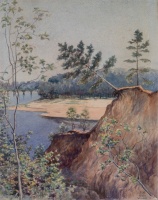
The banks of the Neris. A strategic bridge in Žvėrynas
| Author: |
Stefan Narębski (1892–1966)  |
| Created: | 1932 |
| Material: | paper |
| Technique: | watercolour |
| Dimensions: | 35 × 28 cm |
| Signature: | bottom right: S.N / 1932. / WILNO Inscription on the reverse side: Strategiczny most na Zwierzyncu |
The Vilnius architect St efan Narębski (1892–1966) studied at a specialised gymnasium in Vilnius, and before the First World War he attended the Civil Engineering Institute in St Petersburg and the Polytechnic Institute in Warsaw. He settled in Vilnius in 1928, and worked as a city architect, teaching at Stephen Báthory University until 1939. He designed residential buildings and a school in Antakalnis, restored the Bishops’ Palace, and designed royal sarcophagi for the cathedral crypt. After the Second World War, he left for Poland, and lived in Warsaw. In 1932, Narębski painted a watercolour of the view of the banks of the Neris from Karoliniškės. He conveyed the details very precisely: the sandy banks of the river, the crumbling slopes with fir trees slipping down them, and the bridge over the Neris in the distance. A narrow railway went over the bridge from Vingis Park through Žvėrynas to Saltoniškės. Before the war, the bridge was called ‘strategic’, as it was built in the 1920s for logistical purposes. In Soviet times, part of the railway in Vingis Park was adapted as an amusement for children. The bridge has not survived, but the remains of its abutments are still standing on the riverbank.
Text author Laima Laučkaitė
Source: Law firm Valiunas Ellex art album VILNIUS. TOPOPHILIA I (2014). Compiler and author Laima Laučkaitė






